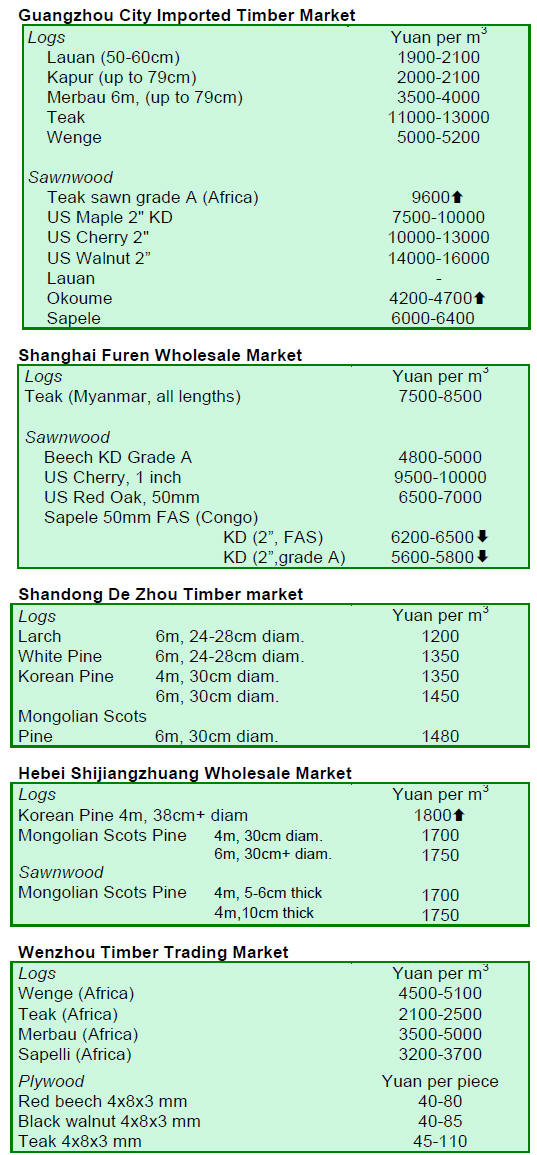US Dollar Exchange Rates of 2th
Mar 2011
China Yuan 6.5725
Report from China
China’s trade in forest products more diversified and expanding
China’s trade in forest products is getting more diversified
as it continues expanding. While trade in primary and
processed products continues to dominate, development in
border, entreport, transit and service trade is also taking
place. There has also been a shift from low value
traditional products and raw materials to high value, and
quality branded finished products.
According to analysts, the main challenges confronting
China’s trade in forest products are:
• International trade in forestry products is expanding
but there is room for greater diversification;
• More pressure, challenges and obstacles to trade;
• Domestic manufactures have limited capacities to
address trade barriers;
• Greater difficulties in gaining access to foreign capital
in the aftermath of the global financial crisis;
• Significant increase of investment risks.
These issues should be addressed during the course of the
implementation of the Twelfth Five Year Plan for the
Forestry, say analysts.
China draws in US$10 billion of foreign capital for the
forest sector
China’s cumulative utilisation of foreign capital for the
development of her forestry sector reached US$10 billion
by the end of 2010. The main forestry actives utilising
foreign capital include afforestation, forest product
industry and forest tourism.
By the end of 2010, some US$3 billion of credits have
been provided by the World Bank, Asian Development
Bank, European Investment Bank, Japan and Germany.
These have been utilised for the development of the
forestry sector in 20 provinces. In addition, Chinese
enterprises have attracted US$6 billion of foreign direct
investments for the establishment of 5 million hectares of
forest plantations. Some of the leading forestry enterprises
in China have been listed on the stock market to gain more
access to international financing.
Meanwhile, China has to date invested in some 130
forestry projects in 21 countries, particularly in Russia.
More than 80 Chinese enterprises have purchased or
rented forest land abroad for logging, primary processing
as well as wood product and furniture manufacturing. The
duration of these investments ranges from 5 to 70 years.
Imports and exports of forest products soared in 2010
According to China Customs, the total value of China’s
trade in forest products soared to US$96.3 billion in 2010,
37% higher than in 2009. The value of forest product
exports surged 34% from 2009, to US$48.8 billion in
2010, while imports climbed 40% from 2009, to US$47.5
billion in 2010.
In terms of imports, the volume and value of logs, wood
chips, furniture and sawnwood have both increased. In
contrast, imports of paper pulp and recycled paper
decreased in volume. The volume of imports of paper pulp
fell 17% from 2009, to 11.37 million tonnes in 2010 but
the value of imports rose 29%, to US$8.8 billion. The
imports of wood chips rose sharply both in volume (67%)
and in value (90%) compared to 2009, reaching 4.65
million tonnes worth US$680 million in 2010.
Wooden furniture is the biggest forest product exported
from China. Exports of wooden furniture in 2010 were
300 million pieces valued at US$16.16 billion, up 21% in
volume and 34% in value compared to 2009. Exports of
paper, paperboard and paper products, plywood and
fibreboard also increased sharply. In contrast, exports of
sawnwood eased slightly to 539,000 cu.m in volume and
US$340 million in value in 2010, down 4% and 1% from
2009 respectively.
Fujian posted sharply higher imports of timber in 2010
According to the information from Fujian Customs, timber
imports through Fujian province in 2010 soared 146% in
volume and 149% in value compared to 2009, reaching
370,700 cu.m worth US$59.8 million in 2010.
Timber imported through Fujian included logs and
sawnwood. The volume of log imports in 2010 was
324,700 cu.m, up 154% over 2009, accounting for 88% of
the total volume of timber imports through Fujian. The
value of log imports rose sharply to US$49.55 million,
172% higher than in 2009 and accounted for 83% of the
total value of timber imports through Fujian. Log imports
of Canadian hemlock, douglas fir, spruce and fir totalled
160,400 cu.m valued at US$20.53 million, representing
49% of the total volume of log imports, up 103% in
volume and 133% in value compared to 2009. Imports of
American spruce, hemlock, cypress logs as well as mixed
logs from other countries were 155,800 cu.m (US$27.83
million), accounting for 48% of the total volume of log
imports, a spectacular surge of 224% in volume and 210%
in value.
Sawnwood and panel imports through Fujian amounted to
46,100 cu.m valued at US$10.21 million, soaring 100% in
volume and 78% in value from the levels in 2009.
Sawnwood imports were mainly Filipino white albizia
panels, American red alder, Chinese fir, cypress panels,
radiate pine from Australia, New Zealand, Brazil and
Chile as well as slash pine panels and Canadian fir panels.
According to analysts, the increase in timber imports
through Fujian can be attributed to the following factors:
• Soaring domestic demand for timber in furniture
production, construction sector, home interior
decoration and improvement is increasing due to rapid
economic development;
• Recovery from the global economic crisis which has
spurred trade and exports of wood products;
• National forest protection policies that have restricted
domestic timber supply and raised the need for
increased imports;
• New clearance and quarantine policies and measures
adopted by Fujian Custom to promote timber imports.

|